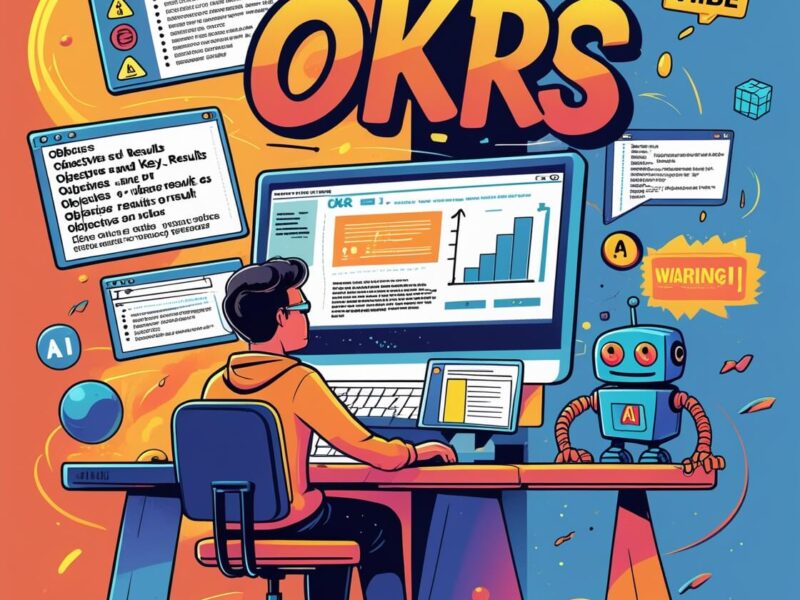The Architect’s Blueprint for Execution Excellence
As a UX designer and solutions architect with over 20 years in tech, I’ve witnessed a critical pattern: Organizations with brilliant visions often fail at execution. The missing link? Strategic alignment of goals. This is where OKRs (Objectives and Key Results) transform ambition into reality.
I. Why Alignment Fails—And How OKRs Fix It
Most strategic plans collapse due to:
Siloed priorities (teams working at cross-purposes)
Vagueness (goals like “improve customer experience” with no measurable outcomes)
Static planning (annual reviews ignoring market shifts)
OKRs solve this by tethering quarterly execution to long-term strategy. At Intel, OKRs enabled the “Operation Crush” campaign that defeated Motorola by aligning 5,000+ employees to a single objective: Dominate the microchip market. Key Results included measurable targets like “Win 2,000 design contracts” .
II. The Strategic Alignment Framework: Cascading From Vision to Action
A. The OKR Pyramid: Linking Time Horizons
Example: Healthcare Provider’s Alignment
Vision: “Transform community health access”
Annual Objective: “Launch telemedicine platform by Q4”
Team KR: “Achieve 500 remote consultations/month”
B. North Star OKRs: The Strategic Anchor
A North Star OKR encapsulates your annual strategic priority. Pinterest uses this to synchronize departments:
North Star Objective: Become the dominant visual discovery engine
Design Team KR: “Increase pin save rate by 20%”
Engineering KR: “Reduce image load time to <1s”
III. Step-by-Step Alignment Process: A Tactical Playbook
Phase 1: Clarify Strategy (Pre-OKR Foundation)
Audit values/mission: E.g., A fintech’s core value: “Democratize financial access” → OKR: “Increase emerging-market users by 40%”
SWOT analysis: Identify 2–3 annual priorities (e.g., “Expand into retail banking”) 7
Phase 2: Craft Aligned OKRs
Objectives: Use the INSPIRE framework :
Inspiring: “Revolutionize mobile checkout UX”
Notable: “Become #1 in retail payment speed”
Specific: “Capture 25% market share in Southeast Asia”
Key Results: Blend lead/lag indicators:
Lag KR: “Increase revenue from banking clients by 25%”
Lead KR: “Launch 3 API integrations with core banking systems”
Table: OKR Alignment Checklist
| Element | Aligned | Misaligned |
|---|---|---|
| Objective | Supports North Star | Repeats BAU tasks |
| Key Result | Measures outcome | Tracks activities |
| Initiatives | Directly impacts KRs | “Seems important” |
Phase 3: Cascade with 60/40 Bottom-Up Input
Google’s model: 40% top-down (strategic must-wins), 60% bottom-up (team-driven innovation). Example:
Leadership Objective: “Improve Android security”
Engineering Team OKR: Reduce critical vulnerabilities by 70%
KR: “Implement automated penetration testing by Q2”
IV. Critical Pitfalls: Why 70% of OKR Implementations Fail
Tool Misuse:
Using OKRs as performance metrics → Incentivizes sandbagging
Fix: Decouple OKR scores from compensation.
BAU Infiltration:
“Respond to customer tickets in 24h” is operational, not strategic.
Fix: Apply the “10X test” (Does this goal enable step-change growth?).
Siloed Creation:
Teams drafting OKRs in isolation → Marketing targets “brand awareness” while sales focuses on “discount-driven conversions.”
Fix: Host alignment workshops with cross-functional leads.
V. Architect-Recommended Toolstack
A. OKR Software
Enterprise: Quantive (AI-driven predictive analytics), WorkBoard (real-time cascading)
SMBs: Monday.com (customizable templates), Asana (goal-tracking integrations)
B. Alignment Frameworks
Pyramid Linking: Embed annual OKRs into strategy maps using OnStrategy’s visual cascading.
Feedback Cadence: Biweekly check-ins using Lattice’s progress dashboards.
VI. Case Study: How Ariadne Labs Scaled Impact
This Harvard-affiliated health lab faced alignment chaos: 100+ medical disciplines pursuing disconnected goals. Their fix:
North Star OKR: Improve clinical care outcomes globally
Departmental Alignment:
Research Team KR: “Publish 5 studies on maternal health interventions”
Tech Team KR: “Launch app reducing NICU admissions by 15%”
Result: 40% faster solution deployment via shared priorities.
Conclusion: Alignment as Competitive Advantage
In dynamic markets, OKRs are your compass. They translate vision into measurable bets, empowering teams to innovate within strategic boundaries. As Andy Grove proved at Intel: Alignment isn’t about everyone doing the same thing—it’s about everyone contributing to the same outcome.
“Strategy isn’t a plan to be executed, but a hypothesis to be continuously tested.”
— Dan Montgomery, OKR Consultant
Free Resource: Download a Strategic OKR Alignment Canvas (based on templates from WhatMatters) to map your pyramid.


